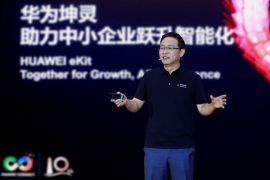The commercial development of 5G will also profoundly affect the global digitalization process. According to the Mobile Economy report of GSMA, 5G will contribute US$961billion global GDP in 2030. By the first quarter of 2022, more than 80 countries and regions have commercially launched 5G services, with 2 million base stations, and been serving 700 million subscribers.
2022 is also a year of accelerating 5G development and making breakthroughs in Asia-Pacific region. South Korea, Thailand, Philippines, Indonesia, Singapore, Maldives, and Bangladesh are deploying 5G in the whole country or top cities. Thailand 5G has reached 77% of population coverage by 2021 based on latest NBTC statics. At the beginning of 2022, 5G subscribers in Asia-Pacific reach 54 million. GSMA predicts that 5G subscriber penetration in Asia-Pacific will exceed 14% by 2025, and 40% in pioneer markets.
In addition, countries have actively explored 5G to enable digital transformation in thousands of industries, including smart healthcare, manufacturing, agriculture, ports, and smart cities. All this indicates that the 5G industry in the Asia-Pacific region is developing in a blooming direction. At the same time, the region is facing severe challenges of 5G spectrum shortage. The prime golden frequency bands for 5G, including 3.5 GHz, 2.6 GHz, and 700 MHz, are being used by other technologies, such as satellites, broadcasting and television. Therefore, accelerating the orderly provision of 5G spectrum is the key to building a sustainable regional ICT industry environment and harmonious ecosystem.
Spectrum provision is the key to 5G technology
ITU estimates that the DOU (Data Of Usage) will exceed 39 GB per user per month in 2025 and 250 GB in 2030. The current monthly MBB data traffic per capita in most of countries in Asia Pacific, especially in ASEAN, has already exceeded 20 GB, and even exceeded 30 GB in Cambodia and Laos. The huge data demand will come earlier than other regions in global.
5G is the preferred technology in the Asia-Pacific region to address this challenge, and spectrum is the key to this technology. According to GSMA and Coleago's assessment and prediction of Asia-Pacific top cities, each country needs to reserve 2000 MHz mid-band (1–10 GHz) spectrum at average in the next 10 years to provide seamless, high-experience, and affordable 5G services.
Currently, the wireless mid-band spectrum that has been distributed to mobile operators is less than 1000 MHz in most countries, such as 360 MHz in Indonesia, 450 MHz in Thailand, 464 MHz in Cambodia, and 505 MHz in Sri Lanka. There is a big gap between the current supply and bandwidth demands of 2000 MHz. Therefore, the mid-band spectrum of 3.5, 2.6, 2.3, and 4.9 GHz need to be considered and provided orderly to meet the increasing data requirements in various countries. In addition, inter-industry coordination and frequency clearance and migration preparations need to be made in advance. On March 31, 2022, Bangladesh completed the auction of 190 MHz 5G spectrum on the 2.6 and 2.3 GHz frequency bands. It supports the refarming of continuous large bandwidth, reduces the unit price per MHz by 58% compared with that of 4G, and extends the deferred payment period from 5 years to 10 years. The series of incentive measures have created a favorable policy environment for the rapid development of 5G.
Besides the mid-band, 700 MHz low band is also an ideal 5G frequency band including in Indonesia, Cambodia, Bangladesh, Sri Lanka, and Nepal, etc. It can provide 4G plus 5G dual services simultaneously via one network with dynamic spectrum sharing technology. It is the key coverage band to bring universal mobile broadband services, and bridge the digital divide between urban and rural areas.
Overall, the full release of 5G's impact on the economy and society depends on the vigorous development of 5G technologies and applications. To achieve this goal, under the guidance of the government, telecom operators, suppliers, academies, content providers, and industries are gradually converged, communicating user requirements, and exploring unified, coordinated, high-performance, and energy efficient 5G products and service models. The next five years will still be a critical period for the development of the 5G industry in the Asia-Pacific region. The whole industry still need to work together to promote the implementation of various policies to build a sustainable and harmonious ecosystem in the region.
6 GHz is an inevitable choice for the 5G in the next 10 years.
3.5 GHz, 2.6 GHz, 2.3 GHz, and 4.9 GHz are the world's preferred and mature 5G prime mid-bands. They provides total 800 MHz bandwidth for the initial stage of 5G development. On that basis, we need to find and reserve a next spectrum band for long-term service development in the next 5 to 10 years to meet the total requirement of 2000 MHz in mid-bands. At the 8th Asia-Pacific Spectrum Conference in April 2022, regulators from China, Thailand, Cambodia, Indonesia, Germany, Finland and other industry organizations such as GSMA reached that consensus.
6 GHz is the last and only choice that can reach the "2 GHz mid-band bandwidth in each country". 6 GHz for IMT has won a wide consensus in the industry. ITU, GSMA, GTI, and 3GPP actively promote 6 GHz IMT research. Leading international operators, such as Vodafone Deutsche Telekom, Orange, Telefonica, China Mobile, and Axiata, support 6 GHz for IMT as a global harmonized spectrum strategy.
In the Asia Pacific region, Thailand, Indonesia, Malaysia, Cambodia, Laos, and Singapore are actively participating in the study and identification of 6GHz IMT under the ITU WRC-23 framework. We believe that 6GHz will become the key band for 5G and 5.5G (5G advanced) development in the Asia Pacific region. Huawei is willing to support the research and testing of 6GHz IMT as global standards by governments, operators, and industry organizations in the region. This will promote the entire industry to unify standards and boost ecosystems, lay out the future ahead of time, and move towards new digital and intelligent world.
By Zhengjun Zhang (Jun Zhang), Director of Huawei Asia-Pacific Public Relations Department, Huawei Technologies Co., Ltd.
Reporter: Zhengjun Zhang (Jun Zhang)
Editor: PR Wire
Copyright © ANTARA 2022












